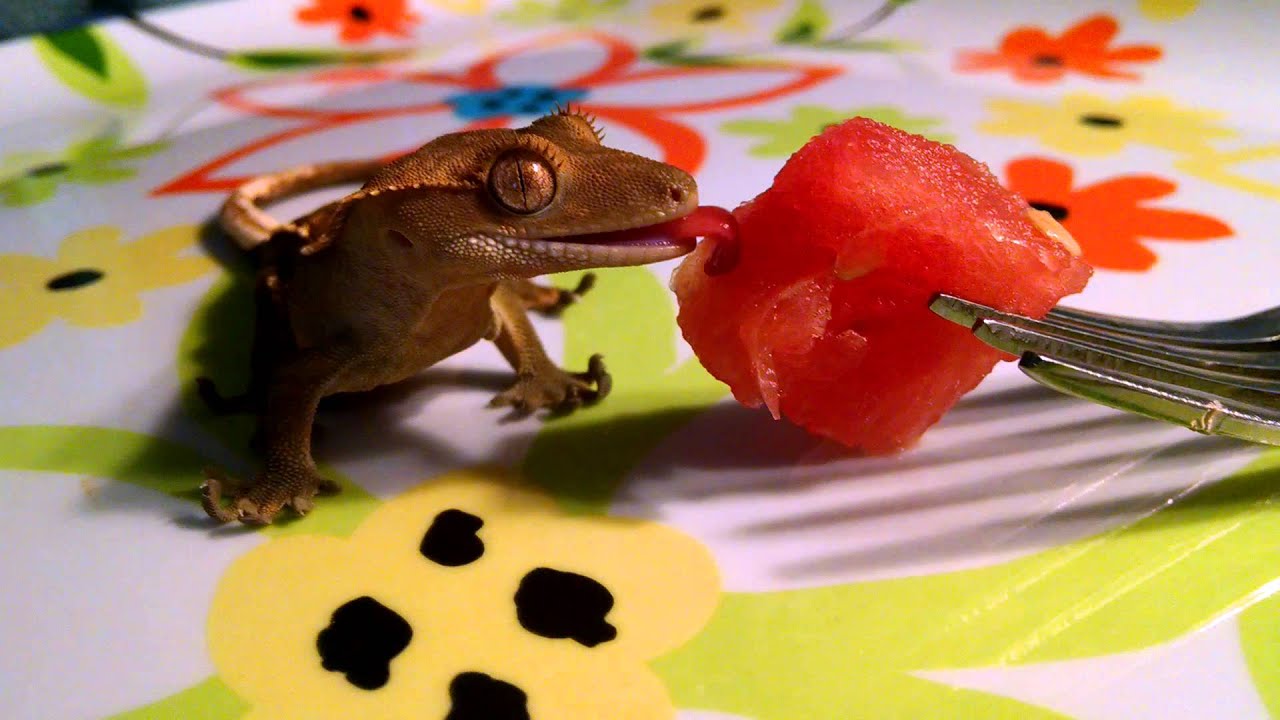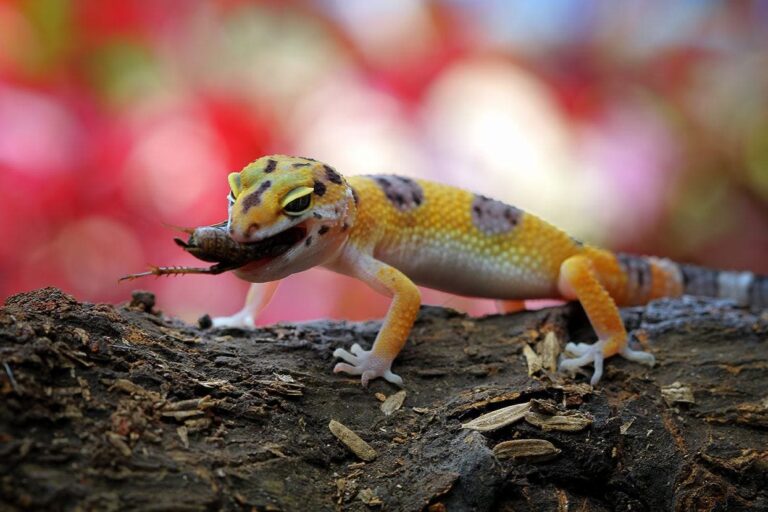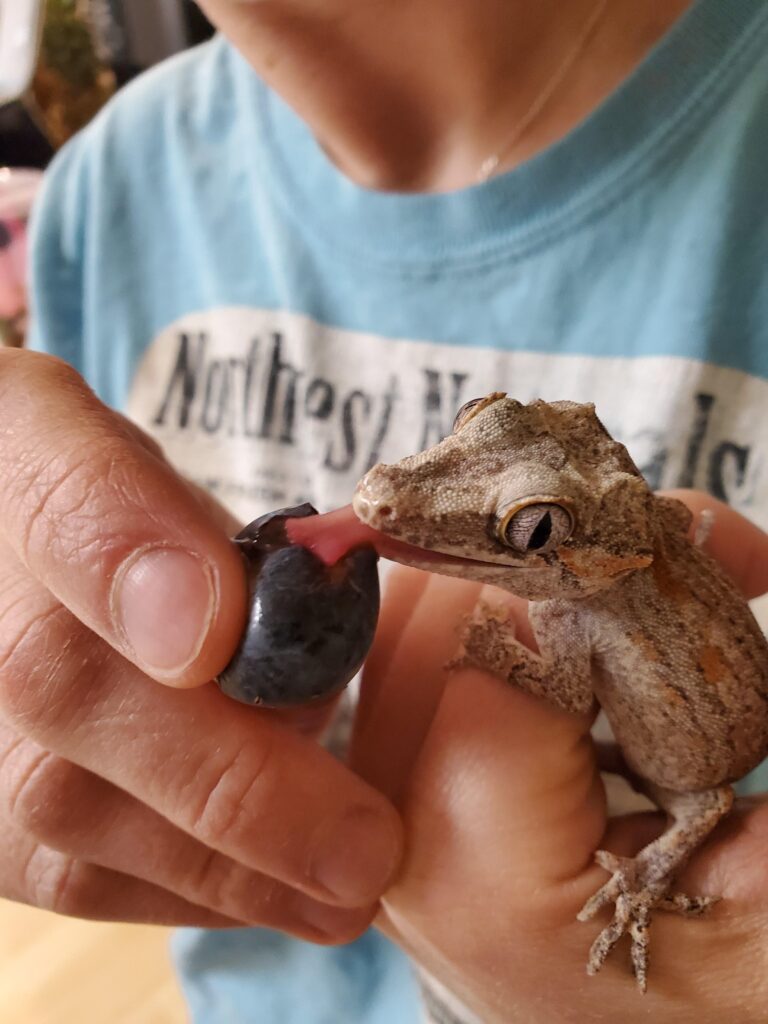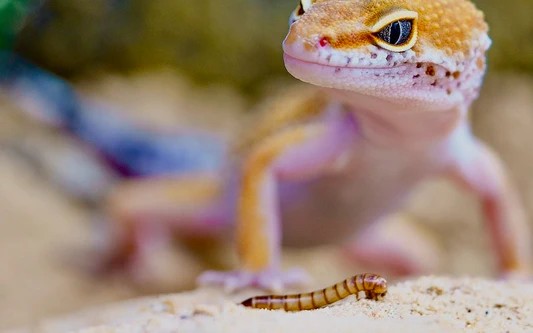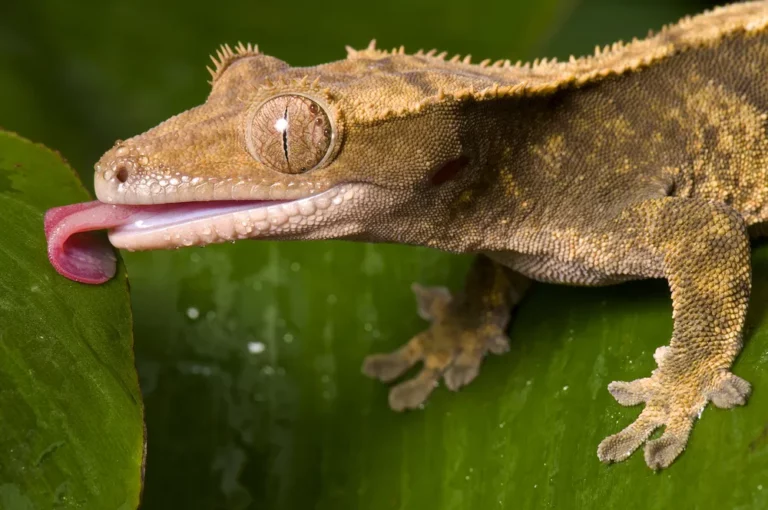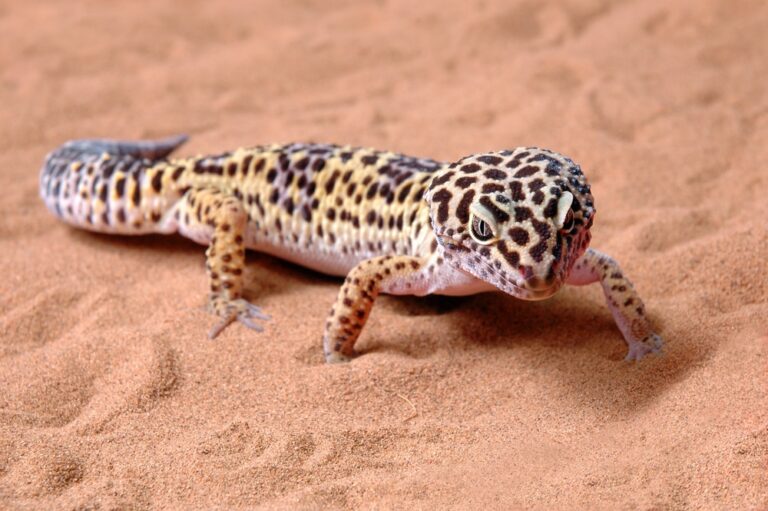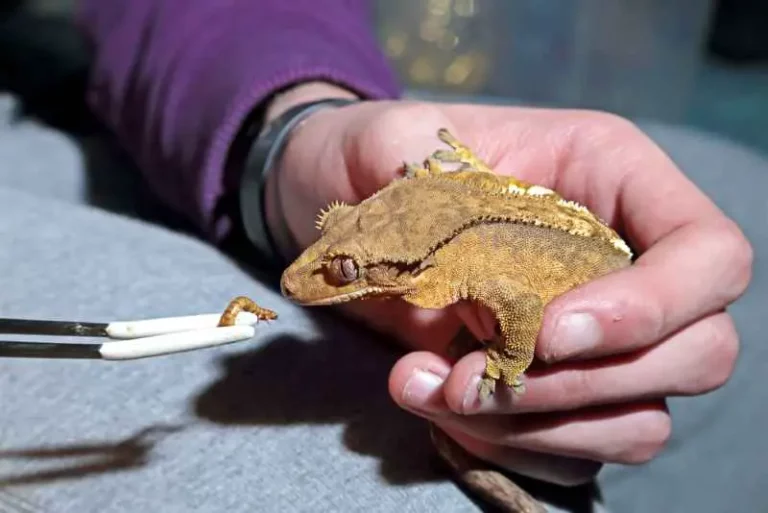Can Crested Geckos Eat Watermelon? The Sweet Secret
As a passionate reptile enthusiast, my journey through the world of exotic pets has led me to some truly fascinating discoveries. The crested gecko, with its distinctive appearance and endearing personality, has long been a favorite among reptile enthusiasts. But as with any pet, it’s essential to provide them with a well-balanced diet to ensure their health and happiness.
Yes, Crested geckos can enjoy watermelon as an occasional treat in their diet. While watermelon offers several health benefits, it’s important to be mindful of its characteristics.
So, let’s embark on this adventure and discover if watermelon can truly be on the menu for these charming reptiles.
Nutritional Value of Watermelon (per 100 grams)
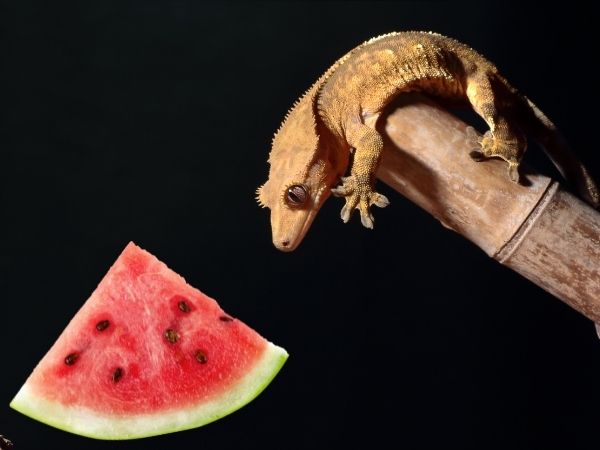
| Nutrient | Amount |
| Calories | 30 kcal |
| Water | 91-96 grams |
| Protein | 0.6 grams |
| Carbohydrates | 7.6 grams |
| Sugars | 6.2 grams |
| Fiber | 0.4 grams |
| Fat | 0.2 grams |
| Vitamin A | 569 IU |
| Vitamin C | 8.1 mg |
| Calcium | 7 mg |
| Phosphorus | 11 mg |
| Potassium | 112 mg |
| Magnesium | 10 mg |
Optimal Hydration: It lives up to its name, containing an impressive 91-96% water content, surpassing most other fruits. This high water content is perfect for keeping your Crested Gecko well-hydrated, and the presence of trace minerals doubles as electrolytes, aiding in effective hydration.
Improved Digestion: It contains a modest amount of fiber, just enough to promote healthy digestion without causing bloating or digestive discomfort. Its low quantity of simple sugars, primarily fructose, makes it easy for geckos to digest, especially when compared to more fibrous fruits like apples or berries.
Low in Sugar and Fat: practically fat-free and has minimal sugar content, making it a nutritious and weight-friendly choice for both normal-weight and overweight Crested Geckos. With just 1.7 grams of sugar per ounce, it offers nutrients and flavor without excessive calories.
Enhanced Eye, Skin, and Bone Health: Watermelon’s standout nutrient is vitamin A in the form of beta-carotene. This micronutrient acts as an antioxidant and plays a vital role in maintaining your gecko’s eye health, critical for their nocturnal lifestyle.
It also promotes healthy skin, aids in shedding, and may even enhance skin color. Moreover, vitamin A contributes to strong and robust bones, complementing calcium and vitamin D intake.
Appropriate Phosphorus Content: Crested Geckos require a well-balanced micronutrient intake, particularly for calcium and phosphorus. Its moderate calcium-to-phosphorus ratio of 1:1, while seemingly suboptimal, doesn’t significantly impact the overall calcium-to-phosphorus ratio of your gecko’s diet due to its low mineral content. This ensures proper calcium absorption and bone health.
Low in Oxalates: Oxalates can interfere with mineral absorption, particularly calcium, leading to lower bone density and kidney stones. Watermelon stands out as one of the lowest-oxalate fruits available, with a minimal oxalic acid content. In fact, your gecko would need to consume a substantial amount of watermelon to intake a mere 1 mg of oxalic acid, making it a safe choice compared to fruits like avocados, oranges, and dates.
Important Considerations and Risks When Feeding Watermelon to Crested Geckos
Here are the risks to keep in mind:
1. Pesticide Exposure:
- Pesticide exposure is a concern when feeding Crested Geckos any fruits, not just watermelon.
- Even organic produce may not be entirely free of pesticides.
- It is often considered safe due to the practice of discarding the pesticide-laden rinds. The edible pulp is typically protected from direct exposure.
- To minimize risk, it is crucial to thoroughly wash it before cutting and serving. Neglecting this step can transfer contaminants from the skin to the pulp, undermining the purpose of choosing cleaner fruit.
2. Harmful Bacteria:
- Melons, including watermelons, have been linked to food poisoning outbreaks.
- It grows close to the ground and can come into contact with various harmful bacteria like salmonella and listeria.
- These bacteria can lead to serious health issues, including infection, vomiting, dehydration, loss of appetite, weight loss, and, in extreme cases, death.
- It is imperative to wash and scrub the watermelon thoroughly before serving. Remember that bacteria on the rind can transfer to the fruit pulp during the cutting process.
- The fruit’s shiny appearance can be deceiving, as it may only receive superficial cleaning. To ensure safety, always prioritize a thorough wash.
Potential Food Addiction:
- Offering frequently might lead to food addiction in your pet
- Crested Geckos can become picky eaters when consistently provided with enticing foods like watermelon.
- The sweetness and refreshing nature can lead to a preference for this fruit over others.
- To avoid this issue, maintain dietary variety by alternating between watermelon and other fruits.
- Additionally, limit the frequency servings to prevent your gecko from developing a strong preference for it.
Serving Watermelon to Your Crested Gecko: A Simple and Vital Process for Their Enjoyment
Here’s a step-by-step guide:
Preparation:
Rinse Thoroughly: Start by rinsing the watermelon with a fruit and veggie wash. While you won’t be feeding your pet the rind, this step helps prevent any inadvertent transfer of pesticides or harmful bacteria. Use cold water and a clean scrub brush for a thorough cleanse.
Remove Seeds: Crested Geckos, being small and delicate, can’t handle seeds, which pose a choking hazard and are difficult to digest. Ensure you meticulously remove all seeds. Alternatively, you can opt for a seedless watermelon to eliminate this step.
Discard the Rind: The tough outer rind of the watermelon is indigestible and should be discarded. Focus on the juicy, pink, or red section for your gecko’s consumption.
Cut into Small Pieces: Slice the watermelon flesh into tiny, manageable pieces. Alternatively, you can use a melon ball scooper to create bite-sized portions. While watermelon is naturally soft, if you have younger Cresties, you can also mash or puree it to make it even easier to eat.
Offering:
Use a Shallow Bowl: Place the prepared watermelon pieces in a shallow bowl. This makes it easier for your Crested Gecko to access and tongue-feed on the fruit.
Monitor Consumption: Observe your gecko while it feeds. Remove any uneaten watermelon pieces after a few hours to prevent attracting insects or causing any mess in the enclosure.
Enhancing Watermelon’s Nutritional Value for Your Crested Gecko
While watermelon offers some health benefits, it’s not a complete diet for Crested Geckos. Mixing it with other foods can help create a more balanced meal. Here are some recommended combinations:
CGD and Papaya: Combining watermelon with Crested Gecko Diet (CGD) and papaya is an excellent choice. CGD is formulated to meet the nutritional needs of Crested Geckos, and papaya is rich in calcium (Ca) relative to phosphorus (P), helping to balance the phosphorus content in watermelon.
Insects: You can blend it with insects like crickets or dubia roaches for added protein. However, keep in mind that insects also have a higher phosphorus content, so this mixture will still have elevated phosphorus levels.
Other Fruits: Mixing it with other fruits like strawberries can provide variety in flavor and nutrients. However, similar to insects, most fruits tend to have higher phosphorus content.
How Often Should Watermelons Be Fed to Cresties?
| Age of Crested Gecko | Feeding Frequency | Watermelon Size |
| Hatchlings (0-3 months) | Once a week | Small, bite-sized pieces |
| Juveniles (3-12 months) | Every 10-14 days | Larger, but still manageable pieces |
| Adults (1 year and older) | Every 2-3 weeks | Larger portions for variety |
Understanding the Critical Calcium-Phosphorus Ratio
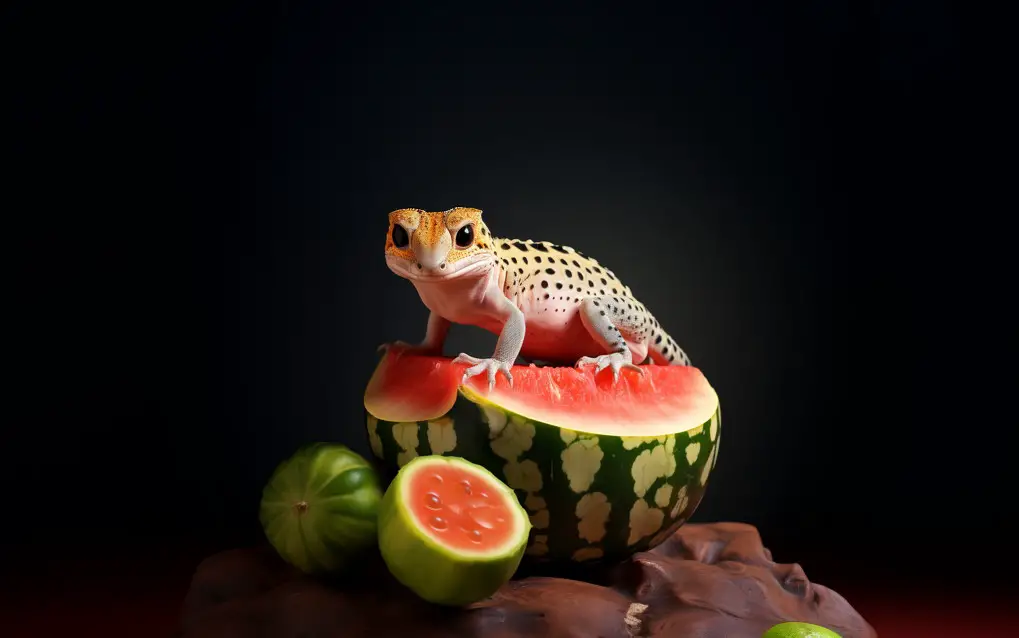
Calcium (Ca) is an essential nutrient for all reptiles, including Crested Geckos. It plays a crucial role in maintaining healthy bones and supports functions such as heart, nerve, and blood function. When the body lacks sufficient dietary calcium, it will draw from its own bone reserves, potentially leading to weakened bones.
Phosphorus (P), on the other hand, can hinder the body’s ability to utilize calcium effectively, compounding the problem.
Many fruits and vegetables naturally contain both calcium and phosphorus, making it challenging to strike the right balance.
The ideal calcium-to-phosphorus ratio for reptiles is 2:1, meaning that every bite of food should contain twice as much calcium as phosphorus to support their health.
Watermelon, unfortunately, falls short in this regard, as it contains 7 milligrams of calcium and 11 milligrams of phosphorus. Based on this ratio, watermelon is not considered an ideal choice for Crested Geckos.
Calcium-to-Phosphorus Ratio for Watermelon:
- Watermelon has a calcium-to-phosphorus ratio of 0.7:1, which is not in line with the ideal 2:1 ratio.
Oxalic Acid Content:
- Oxalic acid can further interfere with calcium absorption in the body, and it’s essential to keep its content in the diet as low as possible. Fortunately, watermelon is very low in oxalic acid, containing only 1 milligram per slice.
FAQs
What Is the right portion size?
A typical portion size for watermelon is about 1 to 2 cups, diced or sliced.
How often can I serve watermelon?
You can enjoy watermelon as often as you like, but moderation is key due to its natural sugar content.
Should you serve watermelon with or without the seeds?
Most people prefer seedless watermelons, but seeded varieties are also edible and can be served if you don’t mind the seeds.
How do I pick a good one?
Look for a watermelon that feels heavy for its size, has a uniform shape, a dull skin (not shiny), and a creamy yellow spot on the bottom (a sign of ripeness).
How long do they keep?
Whole watermelons can last up to 2 weeks if stored in a cool, dry place. Once cut, store in the refrigerator and consume within 3-4 days.
Should I buy organic or conventionally grown melons?
Organic watermelons may have fewer pesticides, but both organic and conventional options can be safe to consume. Choose based on personal preference and budget.
Final words
In conclusion, when it comes to feeding my Crested Gecko watermelon, I’ve learned that moderation is the key. It can indeed be a delightful and hydrating treat, offering some valuable nutrients. However, it’s crucial to be aware of its higher sugar content and the potential impact on calcium levels due to certain compounds.
Further, I’ve come to appreciate that watermelon can be a safe and enjoyable part of my gecko’s diet when offered occasionally and in small, appropriately sized portions. By incorporating it wisely within a balanced diet and maintaining dietary variety, I can provide my pet with a tasty treat while ensuring their overall health and well-being.

